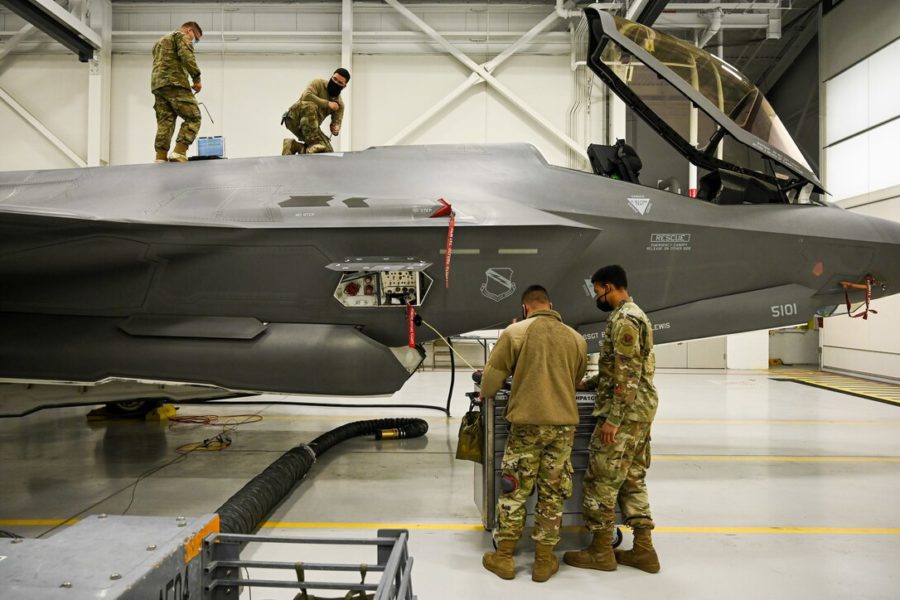A new F-35 sustainment contract to Lockheed Martin “paves the way” toward a performance-based logistics contract that the company has been angling for since 2019 and is worth $6.6 billion if all options are exercised. But all bets are off about hitting the Air Force’s long-term F-35 operating cost goals as Congress mulls whether to develop new engines for the fighter.
The contract, which covers fiscal 2021 and has options for 2022 and 2023, sets cost per flying hour targets for the F-35 that Lockheed Martin must meet.
In 2012 dollars (all F-35 costs are calculated in base year 2012), the cost per flying hour for the Air Force F-35A would improve by $3,600 from current levels, down to $30,000 by 2023. For the global fleet of F-35s—including all three variants, and all international users—the improvement would be 8 percent over the same period, from $36,100 to $33,400.
The Air Force has set a goal of $25,000 per flying hour by 2025 for its F-35As. If it doesn’t get there, Chief of Staff Gen. Charles Q. Brown Jr. has said the service may have to act to address the affordability of the fleet. That could include operating the F-35s less frequently or buying fewer of them, he said.
“We are on the glideslope” to achieving the “25 by 25” goal with the new contract, a Joint Program Office spokeswoman said.
The contract covers the air vehicle only. Pratt & Whitney has separate contracts for management of the F135 engine.
The contract covers “on-site support of day-to-day operations from [Lockheed Martin] field service representatives, engineers, and Autonomic Logistics Information Systems (ALIS) administrators, along with global enterprise support for sustaining engineering, supply chain, repair and replenishment material, and training,” the Joint Program Office said in a press release.
The contract “drives improvements to performance through a refined performance incentive structure focused on year-to-year improvements” in full mission capable and supply rates, the JPO said.
In 2019, Lockheed Martin pitched the Pentagon a performance-based logistics (PBL) plan for the F-35 under which it would achieve the “25 by 25” goal, but it required some investment both by Lockheed Martin and the government.
In February, Lockheed Martin officials said they were negotiating a “skinny” version of the PBL contract with the JPO, under which intermediate cost reductions would be less, though it could still hit the “25 by 25” target. At that time, the company believed it would get a series of “try before buy” five-year contracts to demonstrate that it could achieve the operating cost reductions. The government ruled out longer-term contracts because it was unwilling to lock in a long-term commitment. The company said it can get economic quantity parts and materials costs from its suppliers only if it gets signed assurances that the funding is forthcoming.
The JPO “negotiated aggressive cost savings and performance targets” that will benefit the enterprise and all customers, Program Executive Officer Lt. Gen. Eric T. Fick said in a press statement accompanying the contract award. The JPO is committed to achieving needed capabilities “at a cost our taxpayers can afford.”
The contract “lays the groundwork for a transition to a supply support and demand reduction” PBL in the future, he said.
Hanging over the contract is Congress’ recent move to introduce a new engine for the F-35 derived from the Adaptive Engine Technology Program. The House Armed Services Committee, in its version of the fiscal 2022 National Defense Authorization Act, directed that the JPO create a plan to introduce AETP engines by 2027. That move puts the “25 by 25” goal “in jeopardy,” a government official said.
Both Pratt & Whitney and GE Aviation, which have developed AETP engines, have said their new powerplants can only fit in the F-35A used by the Air Force. Getting the AETP to fit in the Navy’s F-35C version would require significant further development, and both companies have said flatly that their AETP engines “will not fit” in the Marine Corps F-35B short takeoff/vertical landing variant. Following the HASC direction would therefore mean maintaining at least two engine sustainment enterprises for the F-35, which would add to its operating price.
Directing a new engine would add “tremendous increased additional cost,” a government official familiar with the program said. “Adding requirements usually does, at least in the short term.” Hitting the “25 by 25” goal becomes problematic because it’s not known how much the new engines will cost to integrate, and “there are always teething troubles with new engines,” he said.
Another official said “it’s not clear to me that the AETP engine would be exportable. I’m not sure the [international] partners would be very enthusiastic about operating an engine in their F-35s that the U.S. government is, essentially, leaving behind.”
The JPO has said it does not have a requirement for a new engine, nor, in fact, does it have a master propulsion roadmap for the F-35. Establishing one is likely to be on the agenda at the next meeting of F-35 international partners.
“Competition is good,” a government official said, because it can drive better performance and price reductions, but introducing it in the F-35 “at this late stage” in the program will introduce development and multiple unique systems costs that could “easily wipe out whatever you save” in competition.
Pratt & Whitney has said it can make improvements to the F135 engine that now powers the fleet that will save $40 billion in cost avoidance over the life of the F-35, versus developing and fielding new engines for it.
Even if the new engines are developed for the F-35, “there’s still 600 F-35As that fly with the F135, and you have to keep a sustainment enterprise for them,” one official said.
“Trying to change a powerplant in … a fielded system is extremely complex,” said Brig. Gen. Dale R. White, Air Force PEO for fighters and advanced aircraft, in an August press conference, when asked about changing out the F135 engine. Although his portfolio doesn’t include the F-35, White observed that, “You have to think about what the return on investment might be.”
Fick is to meet with reporters Sept. 14 to discuss the way forward on the PBL and potential integration of new F-35 engines.




